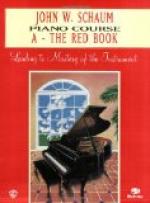“I hope to play both the Brahms and Paderewski concertos in America. To me the latter is a beautiful work—the slow movement is exquisite. I have as yet scarcely done anything with the composition, for I have been on a long tour through Norway, Sweden, and Finland. It was most inspiring to play for these people; they want me to come back to them now, but I cannot do so, nor can I go next season, but after that I shall go. I returned home greatly in need of rest. I shall now begin work in earnest, however, as summer is really the only time I have for study throughout the year. I shall have six full weeks now before we take our usual holiday in the Grindelwald. On the way there we shall stop at Morges and visit Paderewski, and then I will go over the concerto with him and get his ideas as to interpretation.
MEMORIZING BY ANALYSIS
“You ask how I memorize. First I go over the work several times to get a general idea of the whole. Then I analyze it, for I feel it absolutely necessary to know keys, chords, and construction. A work should be so well understood along these lines that it can be played in another key as well as in the one in which it is written. For the actual memorizing of the piece I generally do it phrase by phrase, not always ’each hand alone,’ though occasionally I do this also. I remember learning the Bach A minor Prelude and Fugue in this way. If I were now asked to play any measure or passage in any part of it I could do so; it is mine forever, never to be forgotten.”
Asked about the different ways of teaching the Leschetizky method by various teachers, Miss Goodson said:
“As we all know, people claim to understand and teach the Leschetizky principles who are not competent to do so. I do not recall, for instance, that the professor requires the tips of the fingers to form a straight line on the edge of the keys. I myself have never done this. I believe in a perfectly easy and natural position of hand at the keyboard. When this is the case the finger-tips form a curve, the middle fingers being placed a little farther in on the keys than is natural for the first and fifth. Of course the hand takes an arched position and the joints nearest the tip of the fingers must be firm; there should be no wavering nor giving in there. The whole arm, of course, is relaxed, and swings easily from the shoulder.




